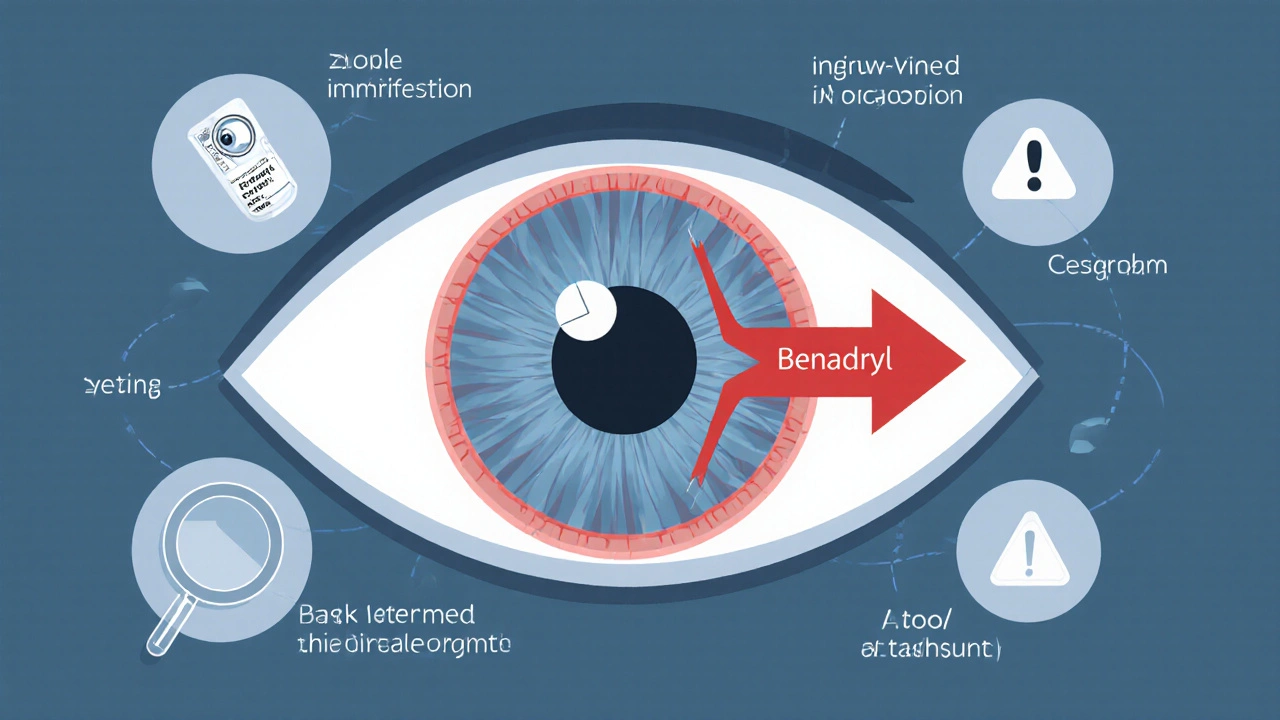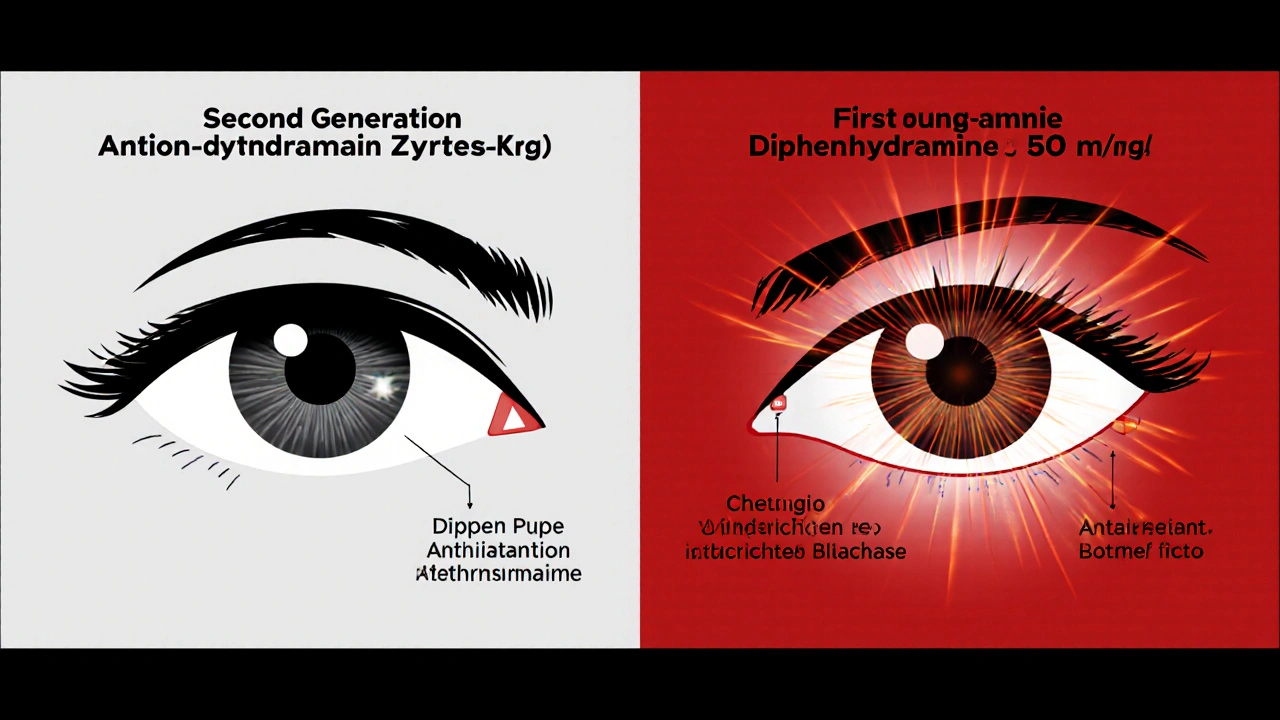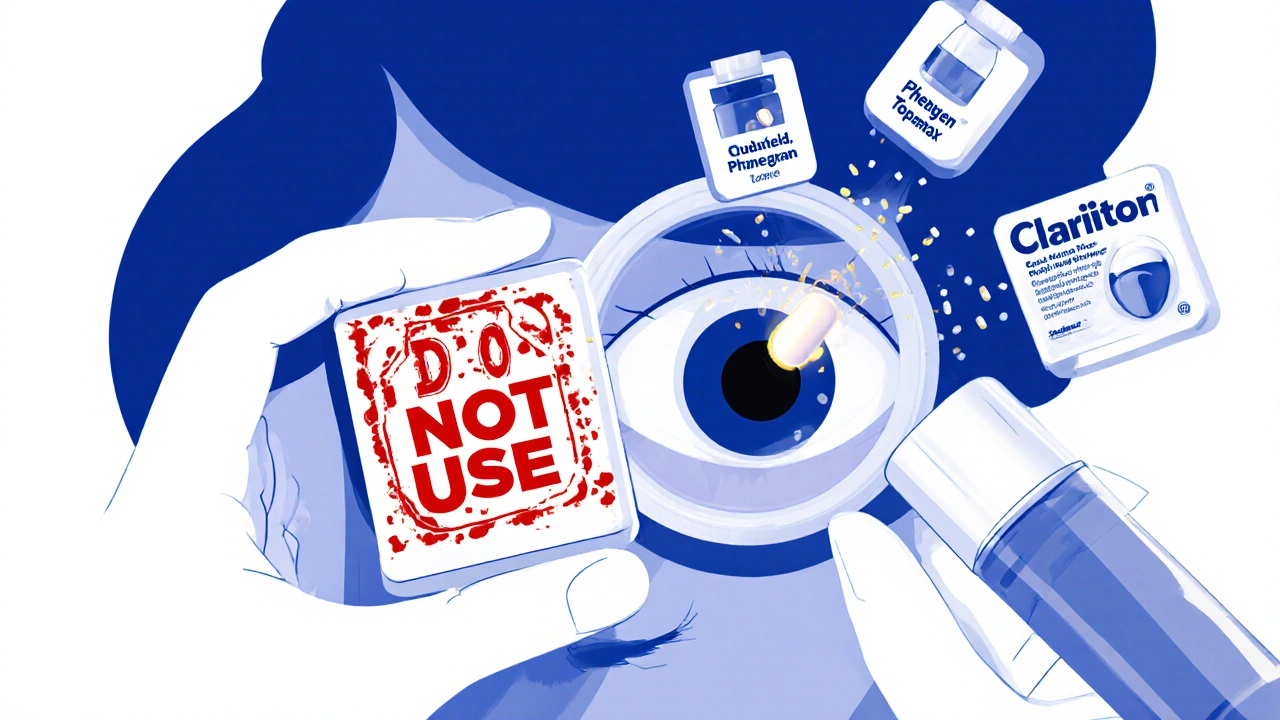Antihistamines and Glaucoma: Why Certain Allergy Medications Can Trigger Vision Loss
 Oct, 30 2025
Oct, 30 2025
Glaucoma Medication Safety Checker
Check if your allergy medication is safe for glaucoma
Many common allergy medications can cause dangerous eye pressure spikes if you have narrow-angle glaucoma. This tool helps you determine if your medication is safe.
Important: If you have narrow-angle glaucoma and take a high-risk medication, see your eye doctor immediately. Emergency treatment is needed within hours.
Every year, millions of people reach for over-the-counter allergy meds like Benadryl, Claritin, or Zyrtec to fight sneezing, itchy eyes, and runny noses. But if you have glaucoma - especially the less common but dangerous type called narrow-angle glaucoma - taking these meds could be like lighting a fuse. You might not feel anything at first. Then, in a matter of hours, your vision blurs, your eye becomes painfully hard, and you see halos around lights. This isn’t just a bad reaction. It’s an emergency that can blind you overnight.
What’s the real danger? It’s not all glaucoma
Not all types of glaucoma react the same way to allergy medications. About 70% of people with glaucoma have primary open-angle glaucoma (POAG). For them, most OTC antihistamines are generally safe. The real risk lies with the 10% to 15% who have narrow-angle glaucoma. In this condition, the drainage channel inside the eye is physically too narrow. It’s like a sink with a clogged pipe - fluid can’t drain properly. When certain drugs cause the pupil to dilate, the iris can bunch up and block that already-tight channel completely. That’s when pressure spikes inside the eye - sometimes to 40 or 50 mmHg (normal is 10-21). This is called acute angle-closure glaucoma, and it’s a medical emergency.Which allergy meds are the worst offenders?
The biggest culprits are first-generation antihistamines with strong anticholinergic effects. These include:- Diphenhydramine (Benadryl, Tylenol PM, Unisom)
- Chlorpheniramine (Chlor-Trimeton)
- Promethazine (Phenergan)
- Meclizine (Bonine, Dramamine)
Decongestants like pseudoephedrine (Sudafed) and phenylephrine (found in many cold and allergy combos) also raise eye pressure. They tighten blood vessels - including those in the eye - which can reduce fluid outflow. And if you’re using steroid nasal sprays, eye drops, or oral steroids for allergies? That’s another red flag. Long-term steroid use - even for just 10 days - can cause steroid-induced glaucoma, which slowly raises pressure and damages the optic nerve. Unlike angle-closure, this form is often silent until vision is already gone.
What about the "safe" antihistamines?
Second-generation antihistamines like loratadine (Claritin), cetirizine (Zyrtec), and fexofenadine (Allegra) are much safer for glaucoma patients. They’re designed to stay out of the brain and eyes, so they don’t cause pupil dilation. But "safer" doesn’t mean "risk-free." Some people still report mild pressure changes, especially if they’re older or have other health conditions. The key is: never assume a medication is safe without checking with your eye doctor.A 2023 clinical trial (NCT04876321) is even testing a new version of loratadine with reduced eye penetration to make it even safer for people with narrow angles. But until that’s available, stick to what’s proven: avoid the old-school antihistamines entirely.

Other sneaky meds that can hurt your eyes
It’s not just allergy meds. Many common prescriptions and OTC drugs can trigger angle closure:- SSRIs and SNRIs - antidepressants like sertraline, escitalopram, and venlafaxine have been linked to acute angle-closure in multiple studies, especially at higher doses.
- Migraine drugs - topiramate (Topamax) and sumatriptan can cause swelling in the eye’s choroid layer, pushing the iris forward and blocking drainage.
- Sulfa drugs - sulfamethoxazole and acetazolamide can cause fluid buildup behind the iris, leading to angle closure.
- Botox injections - if you’ve had Botox around the eyes or forehead, it can alter muscle tension and indirectly increase pressure in people with narrow angles.
Even some blood pressure meds can play a role. Calcium channel blockers and ARBs may slightly raise glaucoma risk, while beta-blockers like timolol (used as eye drops) actually lower pressure. That’s why it’s so important to give your eye doctor your full medication list - not just the allergy pills.
What if you’ve already taken one of these meds?
If you have narrow-angle glaucoma and accidentally took diphenhydramine or a similar drug, don’t panic - but don’t wait either. Watch for these signs:- Sudden blurred vision
- Severe eye pain or headache
- Seeing rainbow-colored halos around lights
- Nausea or vomiting along with eye discomfort
If any of these happen, go to the ER immediately. Acute angle-closure glaucoma can cause permanent vision loss in under 48 hours. Emergency treatment includes eye drops to shrink the pupil, IV medications to lower pressure, and often a laser procedure called iridotomy - where a tiny hole is burned in the iris to create a new drainage path. The sooner you act, the better your chances of saving your sight.
How to protect yourself
The only way to know if you’re at risk is to get a full eye exam. Most people with narrow angles don’t know it - they’ve never had symptoms until a medication triggered an attack. The American Academy of Ophthalmology now recommends gonioscopy - a simple, painless test using a special lens - for everyone over 40 during their first comprehensive eye exam. If you’re over 40 and haven’t had this test, ask for it.If you’ve been diagnosed with narrow-angle glaucoma:
- Avoid all first-generation antihistamines and decongestants.
- Use loratadine, cetirizine, or fexofenadine instead - but still check with your doctor.
- Limit steroid sprays and drops to under 10 days unless monitored by your eye specialist.
- Carry a medical alert card or bracelet stating you have narrow-angle glaucoma. Emergency staff may not know to ask.
- If you’ve had laser iridotomy, your risk is lower - but still not zero. Don’t assume you’re fully protected.

What about natural alternatives?
Many people turn to "natural antihistamines" like quercetin, butterbur, or vitamin C to avoid meds altogether. But here’s the problem: there’s no solid clinical evidence that these work reliably for allergy symptoms - and even less proof they’re safe for glaucoma patients. Some herbal supplements can interact with other medications or even raise eye pressure themselves. Don’t trade one unknown risk for another.Instead, focus on non-medication strategies: use HEPA filters, wash your face and hair after being outside, wear sunglasses to block pollen, and keep windows closed during high-pollen seasons. These won’t cure allergies, but they can cut your exposure - and your need for risky meds.
Why aren’t these warnings on the bottle?
It’s frustrating, but true: most OTC allergy meds don’t clearly warn about glaucoma risks. The FDA doesn’t require it. A 2022 review by Glaucoma UK found that only 1 in 5 packaging labels mention eye conditions. Meanwhile, the global OTC allergy market hit $11.7 billion in 2022. Companies aren’t motivated to add warnings that might scare customers away. That’s why the burden falls on you - and your eye doctor.That’s why every routine eye exam should include a conversation about your medications. Bring your pill bottles. Read the labels out loud. Ask: "Could any of these hurt my eyes?" If your doctor doesn’t ask, ask them. Your vision is worth it.
What’s changing? What’s next?
There’s growing pressure to improve labeling. Glaucoma UK and other advocacy groups are pushing the MHRA and FDA to require clear warnings on all antihistamine packaging. Some researchers are also studying whether statins - commonly used for cholesterol - might actually protect against glaucoma progression. Two studies found slower vision loss in statin users with open-angle glaucoma. It’s early, but it’s promising.As the population ages and glaucoma cases rise (projected to grow 30% globally by 2030), the number of people at risk from these hidden medication dangers will grow too. The good news? Awareness is rising. Eye doctors are now trained to screen for narrow angles. More patients are asking questions. And with better tools and clearer communication, we can prevent many of these sight-threatening emergencies before they happen.
Can I take Claritin if I have glaucoma?
Yes, loratadine (Claritin) is generally considered safe for people with glaucoma because it doesn’t cause pupil dilation. It’s a second-generation antihistamine with minimal effects on the eyes. But always check with your eye doctor first, especially if you have narrow-angle glaucoma or are taking other medications.
Is Benadryl dangerous for glaucoma patients?
Yes, Benadryl (diphenhydramine) is dangerous for people with narrow-angle glaucoma. It causes pupil dilation, which can block the eye’s drainage system and trigger a sudden, sight-threatening spike in eye pressure. Even one dose can cause an emergency. Avoid it completely if you have this type of glaucoma.
How do I know if I have narrow-angle glaucoma?
You won’t know unless you get a gonioscopy - a simple, painless test your eye doctor performs with a special lens during a comprehensive exam. Most people with narrow angles have no symptoms until a medication or dark room triggers an attack. If you’re over 40 and haven’t had this test, ask for it. Early detection prevents emergencies.
Can steroid nasal sprays cause glaucoma?
Yes. Long-term use of steroid nasal sprays, eye drops, or oral steroids - even for more than 10 days - can raise eye pressure and lead to steroid-induced glaucoma. This type is often slow and silent, so regular eye pressure checks are essential if you’re using steroids for allergies. Don’t use them without your eye doctor’s approval.
What should I do if I accidentally took a risky medication?
If you have narrow-angle glaucoma and took diphenhydramine, Benadryl, or another high-risk medication, watch for sudden eye pain, blurred vision, halos around lights, or nausea. If any of these occur, go to the emergency room immediately. Delaying treatment can cause permanent vision loss within hours.
Are there any allergy meds I can safely use with glaucoma?
Yes. Second-generation antihistamines like cetirizine (Zyrtec), loratadine (Claritin), and fexofenadine (Allegra) are much safer because they don’t cause pupil dilation. Antihistamine eye drops like ketotifen (Zaditor) are also safe and effective for itchy eyes. Always confirm with your eye doctor before starting any new medication.
If you have glaucoma, your eyes are more vulnerable than you think. What seems like a harmless cold pill could be a silent threat. The best defense? Know your type. Ask your doctor. Read labels. And never assume a medication is safe just because it’s sold over the counter.
Eric Donald
November 1, 2025 AT 11:40Just had my first gonioscopy last month after my optometrist mentioned this article. I’ve had open-angle glaucoma for years and never knew narrow-angle even existed as a separate thing. This is the kind of info that should be on every OTC bottle. I’m now avoiding anything with diphenhydramine and carrying my medical alert card. Thanks for the clarity.
Khaled El-Sawaf
November 2, 2025 AT 01:38It's not merely a matter of medication safety-it's a systemic failure of pharmaceutical oversight. The FDA has known about anticholinergic risks for decades, yet continues to permit unmarked, unregulated distribution of these substances. The absence of mandatory labeling is not an oversight; it is a calculated decision driven by profit margins and consumer convenience. Patients are being treated as expendable variables in a market-driven healthcare system.
When a child's allergy medication can induce acute angle-closure, and no warning appears on the box, we are no longer in the realm of negligence-we are in the realm of institutional malfeasance. The fact that advocacy groups are still fighting for basic transparency speaks volumes about the corruption of public health priorities.
It is not enough to say 'ask your doctor.' Many patients lack access to specialists. Many are elderly, uninsured, or linguistically isolated. The burden should not fall on the vulnerable to navigate a labyrinth of hidden dangers. The onus must be placed on manufacturers and regulators to disclose risk, clearly and conspicuously, at the point of sale.
This is not an isolated case. It is symptomatic of a broader erosion of informed consent in consumer medicine. If we accept this standard for antihistamines, what other life-altering risks are being quietly buried in fine print? We must demand legislative action-not just personal vigilance.
Nawal Albakri
November 3, 2025 AT 21:23ok but what if the FDA is being controlled by Big Pharma and they dont want you to know that ALL antihistamines are secretly linked to 5D dimensional eye demons that steal your vision through your tear ducts?? i read on a forum that benadryl was originally developed by the NSA to test mind control in veterans and now they pump it into the water supply so you dont notice when your eyes start glowing at night 😳
also my cousin’s neighbor’s dog got glaucoma after eating a claritin pill and now it howls at the moon every tuesday
the real cure is raw garlic and grounding yourself barefoot on a copper plate while whispering ‘i am not a pawn’ 7 times
Jackie R
November 5, 2025 AT 15:00If you’re taking OTC meds without checking with an eye doctor, you’re just asking to go blind. No excuses.
Alexander Ståhlberg
November 6, 2025 AT 23:19Let’s be honest-this isn’t just about glaucoma. It’s about how we’ve outsourced our health to convenience. We want a pill for everything: sleep, allergies, anxiety, inflammation. We don’t want to change our environment, manage stress, or even wash our faces after being outside. We want a chemical fix. And the system gives it to us-without warnings, without context, without responsibility.
Then when someone loses their vision because they popped a Benadryl like a candy, we act shocked. But we’re not shocked that we live in a world where a 72-year-old woman thinks ‘natural’ means ‘safe’ and takes butterbur because it’s on a TikTok trend. We’re not shocked that people don’t know what gonioscopy is. We’re not shocked because we’ve normalized ignorance as the price of ease.
It’s not the drug. It’s the culture. And until we stop treating our bodies like disposable machines that just need the right code to keep running, this will keep happening. Over and over. And the next person who loses their sight won’t even know why.
Josh Arce
November 7, 2025 AT 17:23Wait so Claritin is fine but Benadryl isn’t? But both are antihistamines. That’s like saying one apple is safe and another is poison because one has a slightly different peel. This whole thing feels like a scam to sell you pricier meds. I’ve been taking Benadryl for 20 years. My eyes are fine. Who says this isn’t just fearmongering?
Robert Andersen
November 7, 2025 AT 19:56It’s interesting how we treat medical knowledge like a privilege rather than a right. If you’re wealthy enough to see an ophthalmologist regularly, you’re protected. If you’re not, you’re just rolling the dice every time you take a cold pill. This isn’t just about glaucoma-it’s about healthcare inequality disguised as personal responsibility. The burden shouldn’t be on the patient to know the risks. It should be on the system to make those risks visible.
And yet, here we are. People are dying because the label doesn’t say ‘may cause blindness.’ Not because they didn’t try hard enough. Because the system didn’t care enough.
Brenda Flores
November 9, 2025 AT 01:12Thank you for writing this. I’m 68 and was diagnosed with narrow-angle glaucoma last year after a trip to the ER with severe eye pain. I had no idea. I’d been taking Unisom for years because I couldn’t sleep. My doctor said I was lucky I didn’t lose vision completely. I now carry a card in my wallet and read every label. I wish I’d known sooner. Please, if you’re over 40-ask for gonioscopy. It takes 2 minutes. It could save your sight.
Eli Grinvald
November 10, 2025 AT 07:30Wow this is so important 😢 I just checked my allergy meds and I’ve been taking Tylenol PM… I’m switching to Zyrtec today. Thanks for sharing this! 🙏❤️
Megan Oftedal
November 10, 2025 AT 13:13So I just called my eye doctor and she said I have narrow angles. I’ve been using Sudafed for my sinus issues for months. She said I need to stop immediately and get a laser iridotomy. I’m scared but also relieved I found out before something worse happened. Thank you for this post-it literally saved me from going blind.
robert maisha
November 12, 2025 AT 02:56The medical establishment has long operated under the assumption that patients are capable of self-educating in the face of systemic information asymmetry. This is a fallacy. The burden of understanding pharmacological risk should not rest on the individual when the information is deliberately obscured by commercial interests. The absence of mandatory labeling is not a gap in regulation-it is an active choice to prioritize profit over prevention. We are not merely failing to warn-we are failing to protect. The human cost is not abstract. It is measured in lost vision, in emergency rooms, in families shattered by preventable tragedy. The question is not whether we can do better. The question is whether we still have the moral courage to try.
Musa Aminu
November 12, 2025 AT 11:54Man this is why America is falling apart. You take one pill and now you’re blind? What kind of country lets this happen? In Nigeria we just use neem leaves and pray. No pills. No labels. No problems. You people need to stop trusting chemicals and start trusting God and tradition. This whole thing is a Western scam to make you dependent on doctors and big pharma. I told my cousin to stop taking all that medicine and now his eyes are better than ever. Just say no to Western meds.